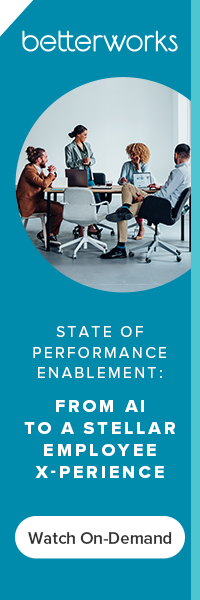Performance management doesn’t occur in a vacuum — it’s linked to every aspect of business and employee growth. So why do we treat it as a “check-the-box” activity, and how can we integrate performance into the rest of the employee experience?
That’s exactly the question we addressed in the webinar “State of Performance Enablement: From AI to a Stellar Employee X-perience.” Betterworks Chief Marketing Officer John Schneider and Content Marketing Manager Michelle Gouldsberry explored some of the most prominent findings from our 2023 State of Performance Enablement report. They also interviewed a panel of HR leaders about applying the research inside organizations.
Check out highlights and insights from the conversation to discover how you can continue enabling employee performance in your organization, or listen to our People Fundamentals podcast that recaps the webinar.
Subscribe wherever you listen to podcasts: Apple Podcasts | Spotify | YouTube
Find the connection between performance and trust
The 2023 State of Performance Enablement report found that employees have far more trust in their peers and direct managers than in HR and organizational leaders. “HR leaders need to mind this trust gap and pull some big levers to close it,” said Gouldsberry. “So what are those big levers?”
One of the biggest factors affecting trust is performance management. “When employees view performance management as failed, trust just collapses,” Gouldsberry said. Trust in HR leaders and direct managers drops by 30% and 40%, respectively. By contrast, trust rises 4x for HR and company leaders and doubles for managers when employees perceive performance management processes to be fair.
Culture and attitudes are another trust lever. “If we want to rebuild trust, we have to be willing to extend it first,” said Ben Eubanks, chief research officer at Lighthouse Research & Advisory. Align perceptions of trust so everyone understands what it means — and when it’s earned.
A common trust gap at work appears between managers and new hires. Some managers say they want new employees to earn their trust. But from the new hire’s perspective, they feel they’ve earned that trust by successfully navigating the hiring process and showing why they were the best candidate.
Reconciling these differences is essential to building a high-trust, high-performance culture. “Your job is to have employees want to trust you,” said Susan Lovegren, an HR leader and member of Betterworks’ HR Advisory Council. Rely on time-honored but essential principles to rebuild employee trust, such as integrity and accountability.
Take advantage of AI
Artificial intelligence has the potential to revolutionize HR, and people leaders need to pay attention. “Embrace it. Learn more about it,” Lovegren said. Use AI to create a holistic HR tech ecosystem rather than fragmented point solutions, she said.
While there is a lot of excitement about AI, it’s important to make sure you bring along those who may be skeptical or unsure about AI, said Andrew Roundtree, director of HR at Best Western International.
AI will give HR leaders more time to lean into the human and strategic elements of HR, says Eubanks. We’re already seeing this impact: Eubanks’ research shows that employees are responding positively to certain AI applications. When you give employees the choice of how to explore career options, he said, they prefer to start with an AI-powered tool before talking with their managers.
Of course, there will always be anxiety about change. It’s up to HR leaders to help the workforce acclimate to and embrace change rather than fear it. “Every company should have a listening strategy,” Lovegren said. One way to do this is by regularly capturing your employee net promoter score, helping you assess employee sentiment through times of change and uncertainty.
Focusing on positive outcomes helped Best Western manage change according to Roundtree. Spelling out the benefits of change increases buy-in and reduces anxiety, he said.
Power potential through conversations
Frequent conversations are among the most powerful elements of performance enablement. At Best Western, Roundtree introduced guidelines and resources to help managers conduct better employee check-ins.
“Conversations have allowed us to give the playbook to these managers to allow them to have meaningful conversations,” Roundtree says. Some of the questions he’s provided for managers include:
- If you could change one thing in your role, allowing you to excel more, what would it be?
- How would you like to grow in this organization to feel a sense of purpose?
- What do you need from your manager to be your best at work?
- What are we currently not doing as a company/department that we should be?
- Do you have an opportunity to do what you do best every day? If not, explain why.
Managers are under increasing stress, however, and many are feeling burned out. To help them adjust to the frequent conversation model, they need additional support.
“They are asked — especially first-line, second-level managers — to still maintain all of the technical work that they have been doing, contributing as an individual contributor, but also contributing as a people manager,” Lovegren said.
HR technology can help with this burden. “Having a playbook, having some tips and tricks and frameworks and technology to help support them at scale is becoming increasingly important,” Lovegren said.
HR leaders have a responsibility to ensure a fair employee deal and a positive employee experience. Staying abreast of new developments in HR and keeping your finger on the pulse of employee sentiment will help you deliver what the workforce needs.
Looking for the full conversation? Watch the webinar on demand.
State of Performance Enablement: From AI to Stellar Employee Experience






